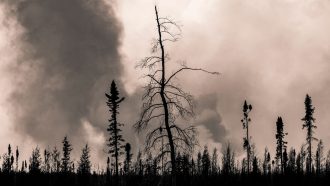
Winter usually kills most forest fires. But in the boreal woods that encircle the far North, some fires, like zombies, just don’t die.
The first broad scientific look at overwintering “zombie fires” reveals these rare occurrences can flare up the year after warmer-than-normal summers and account for up to 38 percent of the total burn area in some regions, researchers report online May 19 in Nature. As climate change accelerates in boreal forests, the frequency of zombie fires could rise and exacerbate warming by releasing more greenhouse gases from the region’s soils, which may house twice as much carbon as Earth’s atmosphere (SN: 4/11/19).
Zombie fires hibernate underground. Blanketed by snow, they smolder through the cold, surviving on the carbon-rich fuel of peat and boreal soil and moving very slowly — just 100 to 500 meters over the winter. Come spring, the fires reemerge near the forest they previously charred, burning fresh fuel well before the traditional fire season starts. Until now, these zombie fires have remained relatively mysterious to science, known mostly from firefighter anecdotes.
Strange coincidences on satellite images, however, got the attention of earth systems scientist Rebecca Scholten and her colleagues. “My adviser noticed that some years, new fires were starting very close to the previous year’s fire,” says Scholten, of Vrije University Amsterdam. This is unusual, she says, since boreal fires are usually sparked by random lightning or human activity. Local fire managers confirmed that these were the same fires, prompting the researchers to wonder just how often fires overwinter.
To find evidence of underground fires, the researchers combined firefighter reports with satellite images of Alaska and northern Canada captured from 2002 to 2018. They looked for blazes that started close to the scars left the previous year and that began before midsummer, when lightning-sparked fires usually occur.
The team found that zombie fires are rare, accounting for 0.8 percent of the total area burned by forest fires in these regions over those 16 years, but there was lots of variability. In 2008, one zombie fire burned approximately 13,700 hectares in Alaska, about 38 percent of all burned areas that year in that state. Zombie fires were more likely to occur, and burn larger swaths of land, after warmer summers that allowed fires to reach deeper into the soil, the researchers found.
Boreal forests are warming faster that the global average and “we’re seeing more hot summers and more large fires and intense burning,” Scholten says. That might set the stage for zombie fires to play a bigger role.
“This is a really welcome advance which could help fire management,” says Jessica McCarty, a geographer at Miami University in Oxford, Ohio, who wasn’t involved in the study. Understanding when zombie fires are more likely to occur could help firefighters identify these areas early, she says, protecting fragile landscapes that house a lot of climate warming gases.
“Some of these soils are thousands of years old,” McCarty says. While “areas we thought were fire resistant are now fire prone” due to climate change, she says, better fire management can make a difference. “We’re not helpless.”


